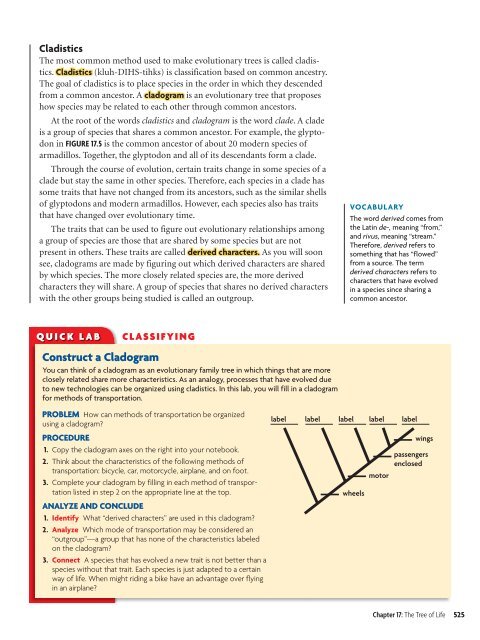Classification and Diversity
Classification and Diversity
Classification and Diversity
You also want an ePaper? Increase the reach of your titles
YUMPU automatically turns print PDFs into web optimized ePapers that Google loves.
Cladistics<br />
The most common method used to make evolutionary trees is called cladistics.<br />
Cladistics (kluh-DIHS-tihks) is classification based on common ancestry.<br />
The goal of cladistics is to place species in the order in which they descended<br />
from a common ancestor. A cladogram is an evolutionary tree that proposes<br />
how species may be related to each other through common ancestors.<br />
At the root of the words cladistics <strong>and</strong> cladogram is the word clade. A clade<br />
is a group of species that shares a common ancestor. For example, the glyptodon<br />
in FIGURE 17.5 is the common ancestor of about 20 modern species of<br />
armadillos. Together, the glyptodon <strong>and</strong> all of its descendants form a clade.<br />
Through the course of evolution, certain traits change in some species of a<br />
clade but stay the same in other species. Therefore, each species in a clade has<br />
some traits that have not changed from its ancestors, such as the similar shells<br />
of glyptodons <strong>and</strong> modern armadillos. However, each species also has traits<br />
that have changed over evolutionary time.<br />
The traits that can be used to figure out evolutionary relationships among<br />
a group of species are those that are shared by some species but are not<br />
present in others. These traits are called derived characters. As you will soon<br />
see, cladograms are made by figuring out which derived characters are shared<br />
by which species. The more closely related species are, the more derived<br />
characters they will share. A group of species that shares no derived characters<br />
with the other groups being studied is called an outgroup.<br />
VOCABULARY<br />
The word derived comes from<br />
the Latin de-, meaning “from,”<br />
<strong>and</strong> rivus, meaning “stream.”<br />
Therefore, derived refers to<br />
something that has “flowed”<br />
from a source. The term<br />
derived characters refers to<br />
characters that have evolved<br />
in a species since sharing a<br />
common ancestor.<br />
QUICK LAB<br />
CLASSIFYING<br />
Construct a Cladogram<br />
You can think of a cladogram as an evolutionary family tree in which things that are more<br />
closely related share more characteristics. As an analogy, processes that have evolved due<br />
to new technologies can be organized using cladistics. In this lab, you will fill in a cladogram<br />
for methods of transportation.<br />
PROBLEM How can methods of transportation be organized<br />
using a cladogram?<br />
PROCEDURE<br />
1. Copy the cladogram axes on the right into your notebook.<br />
2. Think about the characteristics of the following methods of<br />
transportation: bicycle, car, motorcycle, airplane, <strong>and</strong> on foot.<br />
3. Complete your cladogram by filling in each method of transportation<br />
listed in step 2 on the appropriate line at the top.<br />
ANALYZE AND CONCLUDE<br />
1. Identify What “derived characters” are used in this cladogram?<br />
2. Analyze Which mode of transportation may be considered an<br />
“outgroup”—a group that has none of the characteristics labeled<br />
on the cladogram?<br />
3. Connect A species that has evolved a new trait is not better than a<br />
species without that trait. Each species is just adapted to a certain<br />
way of life. When might riding a bike have an advantage over flying<br />
in an airplane?<br />
label label label label label<br />
wheels<br />
wings<br />
passengers<br />
enclosed<br />
motor<br />
Chapter 17: The Tree of Life 525

















